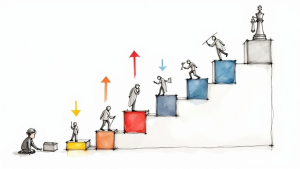Table of Contents
Building Real Accountability Into Product Teams
To be effective in product management, you need a mix of traits: curiosity, empathy, decisiveness, resilience. But one trait stands above the rest — leadership. And not the kind that comes from a title. In product, leadership isn’t given. It’s earned — through clarity, consistency, and how well you help the team move toward shared goals.
Unlike functional managers, most product leaders don’t have direct authority over the people doing the work. You’re not managing their time off, approving expense reports, or deciding annual comp. Instead, you’re building influence through trust. You’re organizing effort and surfacing clarity where none exists. And you’re making sure things don’t just get talked about — they get done.
One of the most powerful tools for this is what Apple famously called the DRI: Directly Responsible Individual. I’ve used it across teams and companies, from early stage startups to public companies. It’s deceptively simple, and incredibly effective.
Let’s dig in.
Ready to drive more growth & achieve bigger impact?
Leverage my 25+ years of successes and failures to unlock your growth and achieve results you never thought possible.
Get StartedWhat Is a DRI? And Why Does It Matter?
The concept of a DRI comes out of Apple, where Steve Jobs insisted that every task — especially those coming out of a meeting — had to have a single name attached to it. Not a team. Not a department. A person.
“Any effective meeting at Apple will have an action list,” said one former employee. “Next to each action item will be the DRI.” And if you didn’t know who to ask about something, you’d hear, “Who’s the DRI on that?”
It wasn’t about control. It was about clarity. The DRI was the person who owned the outcome, who would coordinate and drive it to the finish line. Not necessarily the person doing all the work, but the one who made sure the work got done.
Product teams deal with ambiguity constantly. When everything feels shared, nothing is really owned. The DRI solves that. It makes sure one person is holding the bag — not the whole team holding the air.
DRIs in Practice: What It Looks Like on Healthy Teams
I first saw this in action at TripAdvisor. It wasn’t formalized in a playbook — it was just part of how we worked. If something important needed to happen, someone would say “OK, who’s the DRI?” and we’d all pause until someone raised a hand. From there, that person was accountable — to the team, to the customer, to the outcome.
Was there ever apprehension? Sure. I’ve definitely said yes to DRI-ing something and thought, “Not totally sure how I’ll pull that off... but I’ll figure it out.” And sometimes it came with a groan: “Alright, I guess that’s mine.” But I always took it seriously. Because I knew others were counting on me.
Ready to drive more growth & achieve bigger impact?
Leverage my 25+ years of successes and failures to unlock your growth and achieve results you never thought possible.
Get StartedHere’s how the DRI mindset plays out in little ways that add up fast:
Email fields become signals.
If you’re the DRI, you’re in the To: line. Everyone else is CC’d. That clarity lets people scan quickly and know what’s expected of them.
Ownership is front-loaded.
On complex or fuzzy projects, one of the first questions should be: “Who’s the DRI here?” Don’t wait until a deadline is missed or a ball is dropped.
Meetings create action, not confusion.
The best meetings end with next steps. Not vague ones — specific actions with specific names. “Who’s got this?” is a good muscle to build.
Ambiguity gets answered with accountability.
If an email hits your inbox and you’re not sure who’s responding, the DRI framework helps. You ask, “Is this mine?” not “Is someone else handling this?”
When these behaviors become second nature, everything runs smoother. The team doesn’t spin its wheels. Everyone knows who to go to. Nothing gets stuck because everyone assumed someone else was taking care of it.
What DRIs Are Not
It’s easy to misunderstand the DRI concept. So let’s get clear on what it’s not.
A DRI is not the only person doing the work. They’re responsible, not solo. They may pull in collaborators, delegate parts, or bring in support — but they’re the one who makes sure the task crosses the finish line.
Ready to drive more growth & achieve bigger impact?
Leverage my 25+ years of successes and failures to unlock your growth and achieve results you never thought possible.
Get StartedIt’s also not a weapon. DRIs don’t exist so managers can say “Well, that was your fault.” This isn’t about blame. It’s about clarity and commitment. If you create a blame-y culture, you’ll get fewer volunteers, more finger-pointing, and a team that’s afraid to take risks. DRIs work best in cultures of trust, not fear.
When Product Teams Lack DRIs
When product teams don’t use a DRI model, things get messy fast. Here’s what you usually see:
• Tasks get dropped, because no one really owns them.
• Follow-ups don’t happen, because there’s no point person.
• Communication is scattered, with different people assuming different things.
• Meetings result in nice discussions, but no outcomes.
• Teams become reactive, not proactive, and rely more on escalation to resolve ambiguity.
Eventually, leaders start stepping in more often to assign work and resolve confusion — which can slow everyone down and burn out managers. The team becomes dependent, not empowered.
That’s not what we want. We want a culture where people step up, sort it out, and move things forward. DRIs give us that.
How to Introduce DRIs to Your Team
If your team doesn’t already use DRIs, here’s how to start without making it a huge process overhaul:
- Model it. Start with your own work. When you lead a meeting, assign clear owners for every action item. When something is assigned to you, take ownership publicly.
- Name it. Use the term DRI out loud. “OK, who’s the DRI on this?” makes it easier to establish than “Who wants to...?” It’s a known concept for many teams — don’t be afraid to borrow the language.
- Make it a norm. In retros, ask “Did we drop any balls because ownership wasn’t clear?” Use that as a prompt to improve.
- Keep it light. This doesn’t have to be a heavy process. It’s a simple habit that creates massive clarity.
- Celebrate ownership. When someone DRI’s a project well, give them props. Recognition reinforces the culture you want.
Ready to drive more growth & achieve bigger impact?
Leverage my 25+ years of successes and failures to unlock your growth and achieve results you never thought possible.
Get StartedWhy DRIs Make Great Product Teams Even Better
The best product teams are built on trust, not command-and-control. They don’t wait around for someone to tell them what to do — they figure it out, together. That only works if people feel safe stepping up, and if they know they’re not stepping into a vacuum.
DRIs are how we make that real.
They build a culture where “I got this” is the norm. Where progress is expected, not optional. And where the product manager doesn’t have to chase every detail, because accountability is shared across the team.
So if you’re trying to scale, trying to ship more, or just trying to make your team more effective — start with ownership. Create space for DRIs. Normalize clear accountability. And watch your team’s energy shift.
You don’t need more process. You need more clarity. DRIs deliver that. Every time.
Ready to drive more growth & achieve bigger impact?
Leverage my 25+ years of successes and failures to unlock your growth and achieve results you never thought possible.
Get Started



